Complex Patient Plan of Care and Individual Written Report
VerifiedAdded on 2023/06/10
|7
|2067
|264
AI Summary
This report discusses the case study of Joan Blackmore, who is facing health issues such as hypoxia and pressure injury. The report includes the pathophysiology and clinical manifestation of these issues, nursing considerations and interventions, identification of intended goals of care and patient outcomes. The report concludes that effective nursing intervention is necessary for the better health of the patient.
Contribute Materials
Your contribution can guide someone’s learning journey. Share your
documents today.
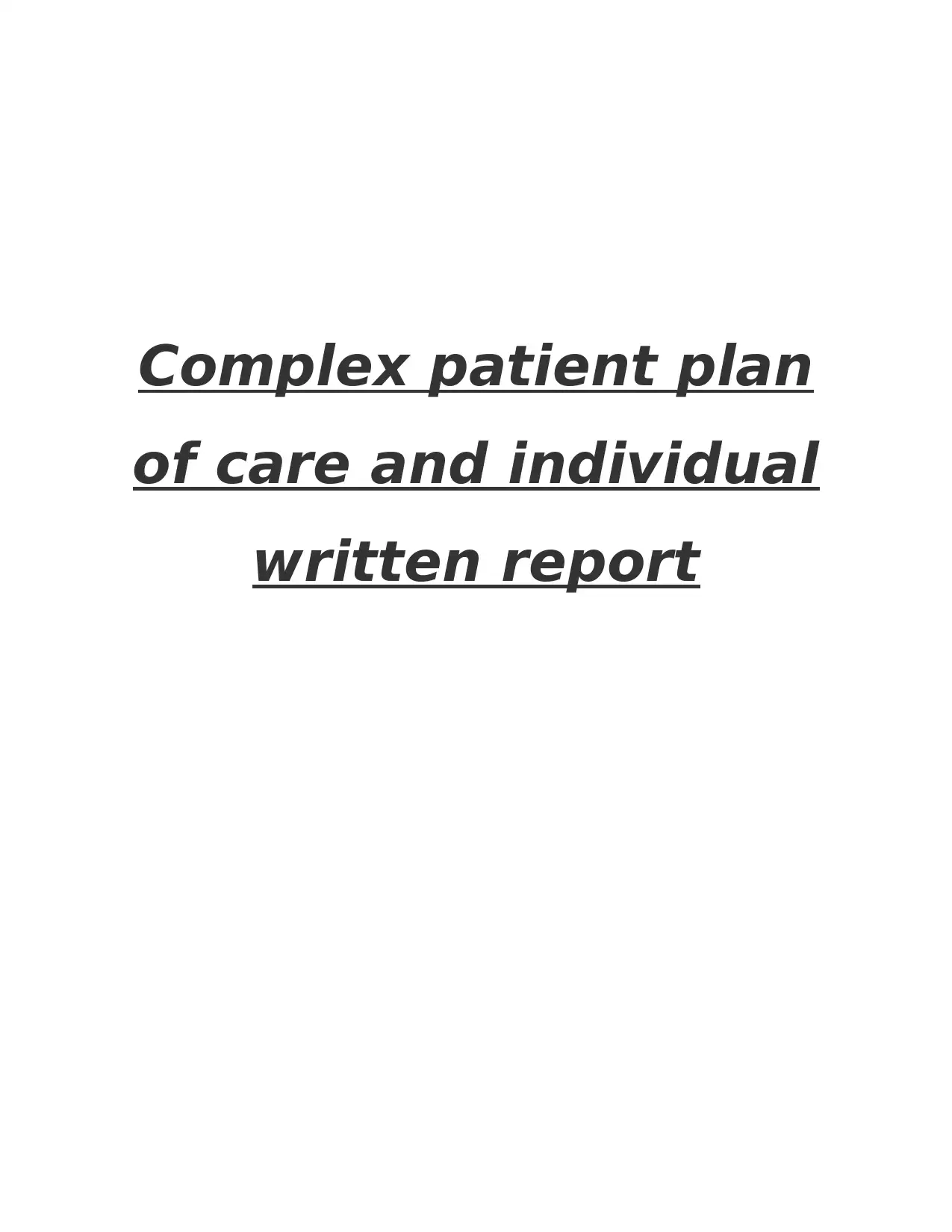
Complex patient plan
of care and individual
written report
of care and individual
written report
Secure Best Marks with AI Grader
Need help grading? Try our AI Grader for instant feedback on your assignments.
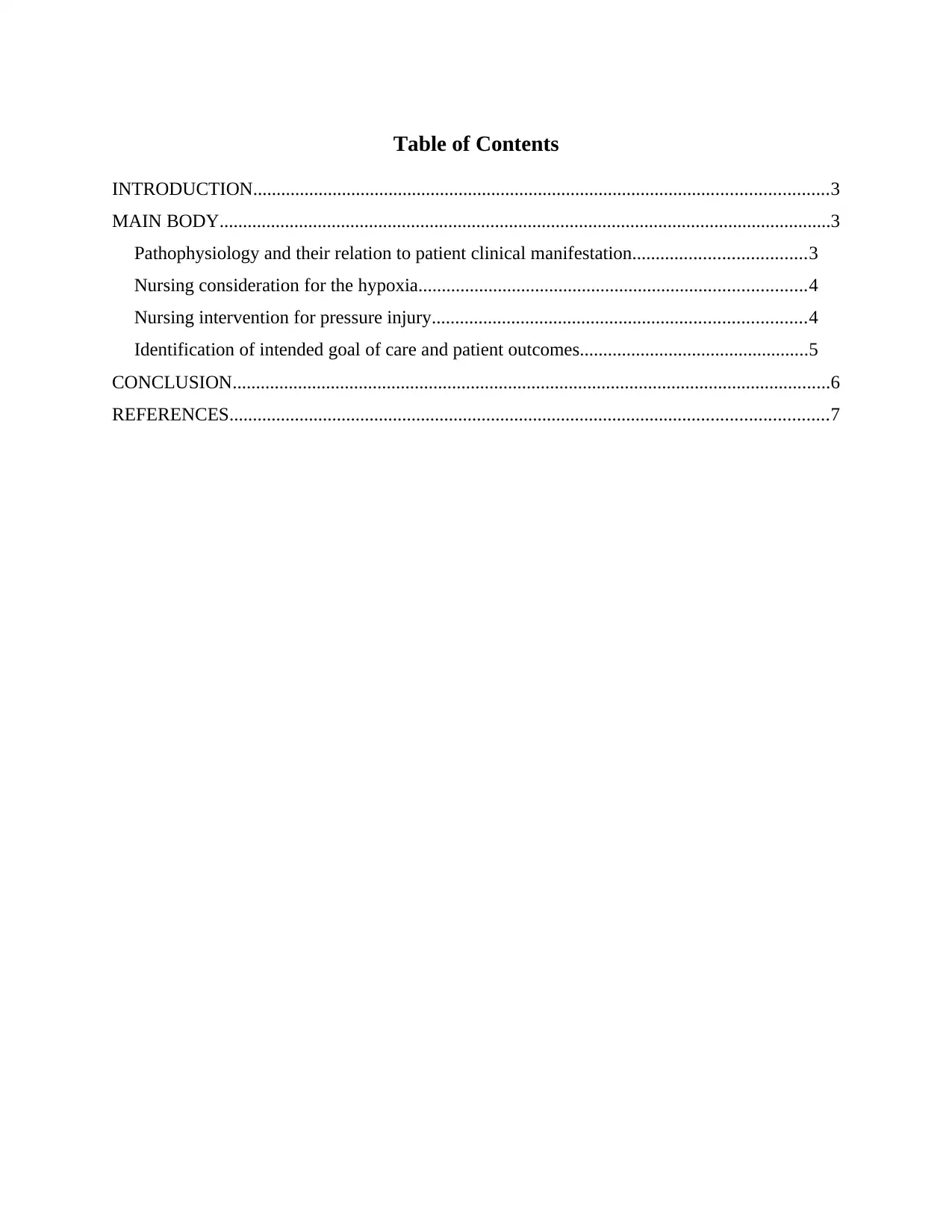
Table of Contents
INTRODUCTION...........................................................................................................................3
MAIN BODY...................................................................................................................................3
Pathophysiology and their relation to patient clinical manifestation.....................................3
Nursing consideration for the hypoxia...................................................................................4
Nursing intervention for pressure injury................................................................................4
Identification of intended goal of care and patient outcomes.................................................5
CONCLUSION................................................................................................................................6
REFERENCES................................................................................................................................7
INTRODUCTION...........................................................................................................................3
MAIN BODY...................................................................................................................................3
Pathophysiology and their relation to patient clinical manifestation.....................................3
Nursing consideration for the hypoxia...................................................................................4
Nursing intervention for pressure injury................................................................................4
Identification of intended goal of care and patient outcomes.................................................5
CONCLUSION................................................................................................................................6
REFERENCES................................................................................................................................7
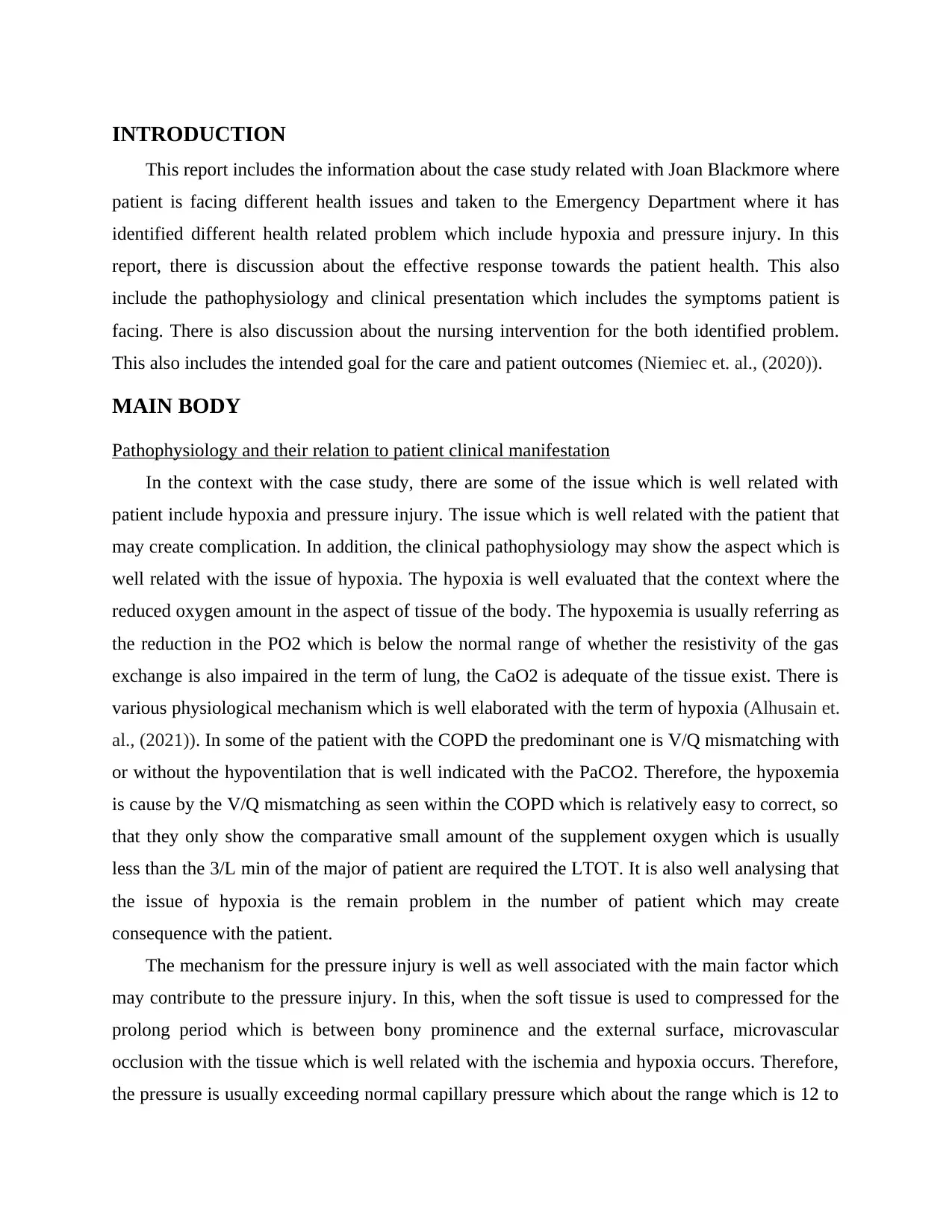
INTRODUCTION
This report includes the information about the case study related with Joan Blackmore where
patient is facing different health issues and taken to the Emergency Department where it has
identified different health related problem which include hypoxia and pressure injury. In this
report, there is discussion about the effective response towards the patient health. This also
include the pathophysiology and clinical presentation which includes the symptoms patient is
facing. There is also discussion about the nursing intervention for the both identified problem.
This also includes the intended goal for the care and patient outcomes (Niemiec et. al., (2020)).
MAIN BODY
Pathophysiology and their relation to patient clinical manifestation
In the context with the case study, there are some of the issue which is well related with
patient include hypoxia and pressure injury. The issue which is well related with the patient that
may create complication. In addition, the clinical pathophysiology may show the aspect which is
well related with the issue of hypoxia. The hypoxia is well evaluated that the context where the
reduced oxygen amount in the aspect of tissue of the body. The hypoxemia is usually referring as
the reduction in the PO2 which is below the normal range of whether the resistivity of the gas
exchange is also impaired in the term of lung, the CaO2 is adequate of the tissue exist. There is
various physiological mechanism which is well elaborated with the term of hypoxia (Alhusain et.
al., (2021)). In some of the patient with the COPD the predominant one is V/Q mismatching with
or without the hypoventilation that is well indicated with the PaCO2. Therefore, the hypoxemia
is cause by the V/Q mismatching as seen within the COPD which is relatively easy to correct, so
that they only show the comparative small amount of the supplement oxygen which is usually
less than the 3/L min of the major of patient are required the LTOT. It is also well analysing that
the issue of hypoxia is the remain problem in the number of patient which may create
consequence with the patient.
The mechanism for the pressure injury is well as well associated with the main factor which
may contribute to the pressure injury. In this, when the soft tissue is used to compressed for the
prolong period which is between bony prominence and the external surface, microvascular
occlusion with the tissue which is well related with the ischemia and hypoxia occurs. Therefore,
the pressure is usually exceeding normal capillary pressure which about the range which is 12 to
This report includes the information about the case study related with Joan Blackmore where
patient is facing different health issues and taken to the Emergency Department where it has
identified different health related problem which include hypoxia and pressure injury. In this
report, there is discussion about the effective response towards the patient health. This also
include the pathophysiology and clinical presentation which includes the symptoms patient is
facing. There is also discussion about the nursing intervention for the both identified problem.
This also includes the intended goal for the care and patient outcomes (Niemiec et. al., (2020)).
MAIN BODY
Pathophysiology and their relation to patient clinical manifestation
In the context with the case study, there are some of the issue which is well related with
patient include hypoxia and pressure injury. The issue which is well related with the patient that
may create complication. In addition, the clinical pathophysiology may show the aspect which is
well related with the issue of hypoxia. The hypoxia is well evaluated that the context where the
reduced oxygen amount in the aspect of tissue of the body. The hypoxemia is usually referring as
the reduction in the PO2 which is below the normal range of whether the resistivity of the gas
exchange is also impaired in the term of lung, the CaO2 is adequate of the tissue exist. There is
various physiological mechanism which is well elaborated with the term of hypoxia (Alhusain et.
al., (2021)). In some of the patient with the COPD the predominant one is V/Q mismatching with
or without the hypoventilation that is well indicated with the PaCO2. Therefore, the hypoxemia
is cause by the V/Q mismatching as seen within the COPD which is relatively easy to correct, so
that they only show the comparative small amount of the supplement oxygen which is usually
less than the 3/L min of the major of patient are required the LTOT. It is also well analysing that
the issue of hypoxia is the remain problem in the number of patient which may create
consequence with the patient.
The mechanism for the pressure injury is well as well associated with the main factor which
may contribute to the pressure injury. In this, when the soft tissue is used to compressed for the
prolong period which is between bony prominence and the external surface, microvascular
occlusion with the tissue which is well related with the ischemia and hypoxia occurs. Therefore,
the pressure is usually exceeding normal capillary pressure which about the range which is 12 to
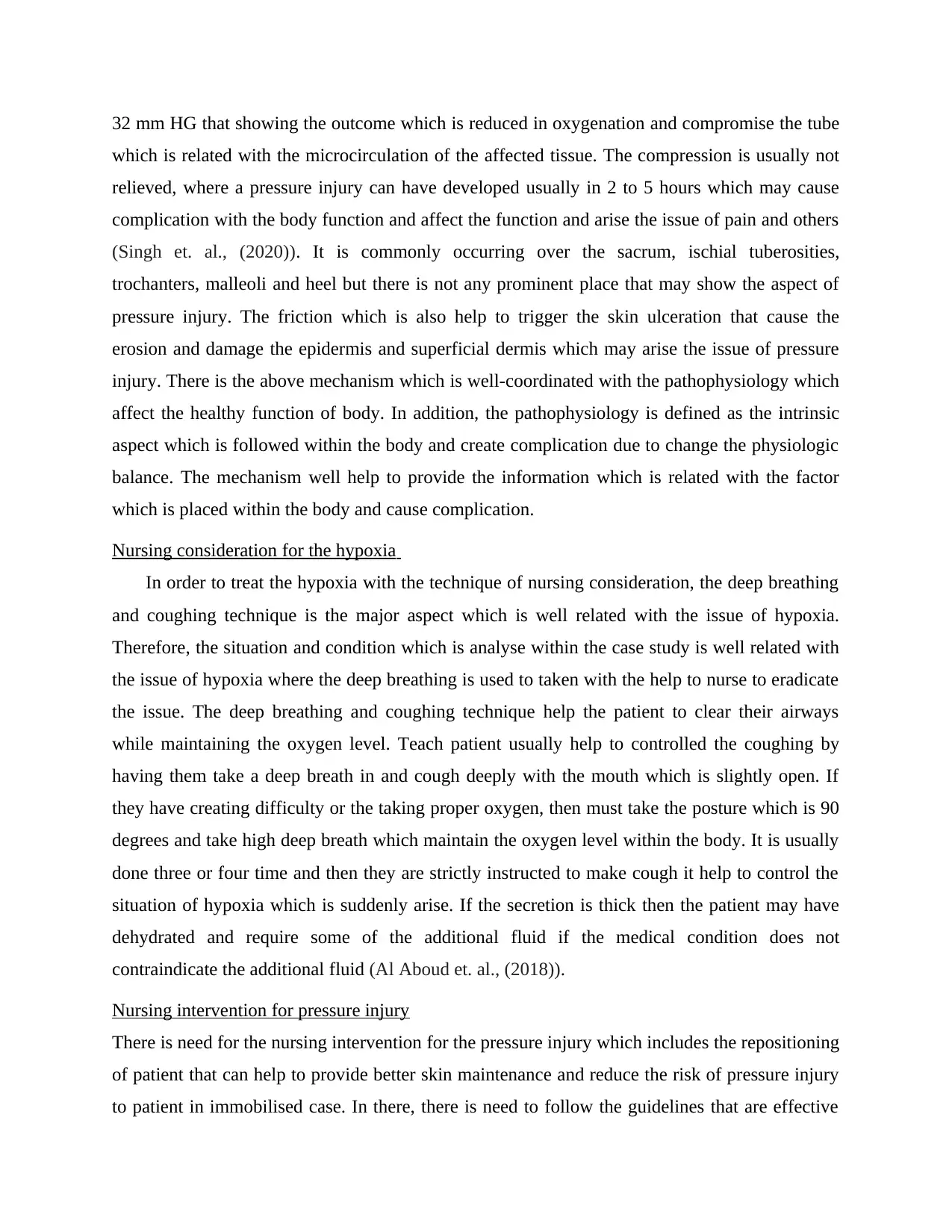
32 mm HG that showing the outcome which is reduced in oxygenation and compromise the tube
which is related with the microcirculation of the affected tissue. The compression is usually not
relieved, where a pressure injury can have developed usually in 2 to 5 hours which may cause
complication with the body function and affect the function and arise the issue of pain and others
(Singh et. al., (2020)). It is commonly occurring over the sacrum, ischial tuberosities,
trochanters, malleoli and heel but there is not any prominent place that may show the aspect of
pressure injury. The friction which is also help to trigger the skin ulceration that cause the
erosion and damage the epidermis and superficial dermis which may arise the issue of pressure
injury. There is the above mechanism which is well-coordinated with the pathophysiology which
affect the healthy function of body. In addition, the pathophysiology is defined as the intrinsic
aspect which is followed within the body and create complication due to change the physiologic
balance. The mechanism well help to provide the information which is related with the factor
which is placed within the body and cause complication.
Nursing consideration for the hypoxia
In order to treat the hypoxia with the technique of nursing consideration, the deep breathing
and coughing technique is the major aspect which is well related with the issue of hypoxia.
Therefore, the situation and condition which is analyse within the case study is well related with
the issue of hypoxia where the deep breathing is used to taken with the help to nurse to eradicate
the issue. The deep breathing and coughing technique help the patient to clear their airways
while maintaining the oxygen level. Teach patient usually help to controlled the coughing by
having them take a deep breath in and cough deeply with the mouth which is slightly open. If
they have creating difficulty or the taking proper oxygen, then must take the posture which is 90
degrees and take high deep breath which maintain the oxygen level within the body. It is usually
done three or four time and then they are strictly instructed to make cough it help to control the
situation of hypoxia which is suddenly arise. If the secretion is thick then the patient may have
dehydrated and require some of the additional fluid if the medical condition does not
contraindicate the additional fluid (Al Aboud et. al., (2018)).
Nursing intervention for pressure injury
There is need for the nursing intervention for the pressure injury which includes the repositioning
of patient that can help to provide better skin maintenance and reduce the risk of pressure injury
to patient in immobilised case. In there, there is need to follow the guidelines that are effective
which is related with the microcirculation of the affected tissue. The compression is usually not
relieved, where a pressure injury can have developed usually in 2 to 5 hours which may cause
complication with the body function and affect the function and arise the issue of pain and others
(Singh et. al., (2020)). It is commonly occurring over the sacrum, ischial tuberosities,
trochanters, malleoli and heel but there is not any prominent place that may show the aspect of
pressure injury. The friction which is also help to trigger the skin ulceration that cause the
erosion and damage the epidermis and superficial dermis which may arise the issue of pressure
injury. There is the above mechanism which is well-coordinated with the pathophysiology which
affect the healthy function of body. In addition, the pathophysiology is defined as the intrinsic
aspect which is followed within the body and create complication due to change the physiologic
balance. The mechanism well help to provide the information which is related with the factor
which is placed within the body and cause complication.
Nursing consideration for the hypoxia
In order to treat the hypoxia with the technique of nursing consideration, the deep breathing
and coughing technique is the major aspect which is well related with the issue of hypoxia.
Therefore, the situation and condition which is analyse within the case study is well related with
the issue of hypoxia where the deep breathing is used to taken with the help to nurse to eradicate
the issue. The deep breathing and coughing technique help the patient to clear their airways
while maintaining the oxygen level. Teach patient usually help to controlled the coughing by
having them take a deep breath in and cough deeply with the mouth which is slightly open. If
they have creating difficulty or the taking proper oxygen, then must take the posture which is 90
degrees and take high deep breath which maintain the oxygen level within the body. It is usually
done three or four time and then they are strictly instructed to make cough it help to control the
situation of hypoxia which is suddenly arise. If the secretion is thick then the patient may have
dehydrated and require some of the additional fluid if the medical condition does not
contraindicate the additional fluid (Al Aboud et. al., (2018)).
Nursing intervention for pressure injury
There is need for the nursing intervention for the pressure injury which includes the repositioning
of patient that can help to provide better skin maintenance and reduce the risk of pressure injury
to patient in immobilised case. In there, there is need to follow the guidelines that are effective
Secure Best Marks with AI Grader
Need help grading? Try our AI Grader for instant feedback on your assignments.
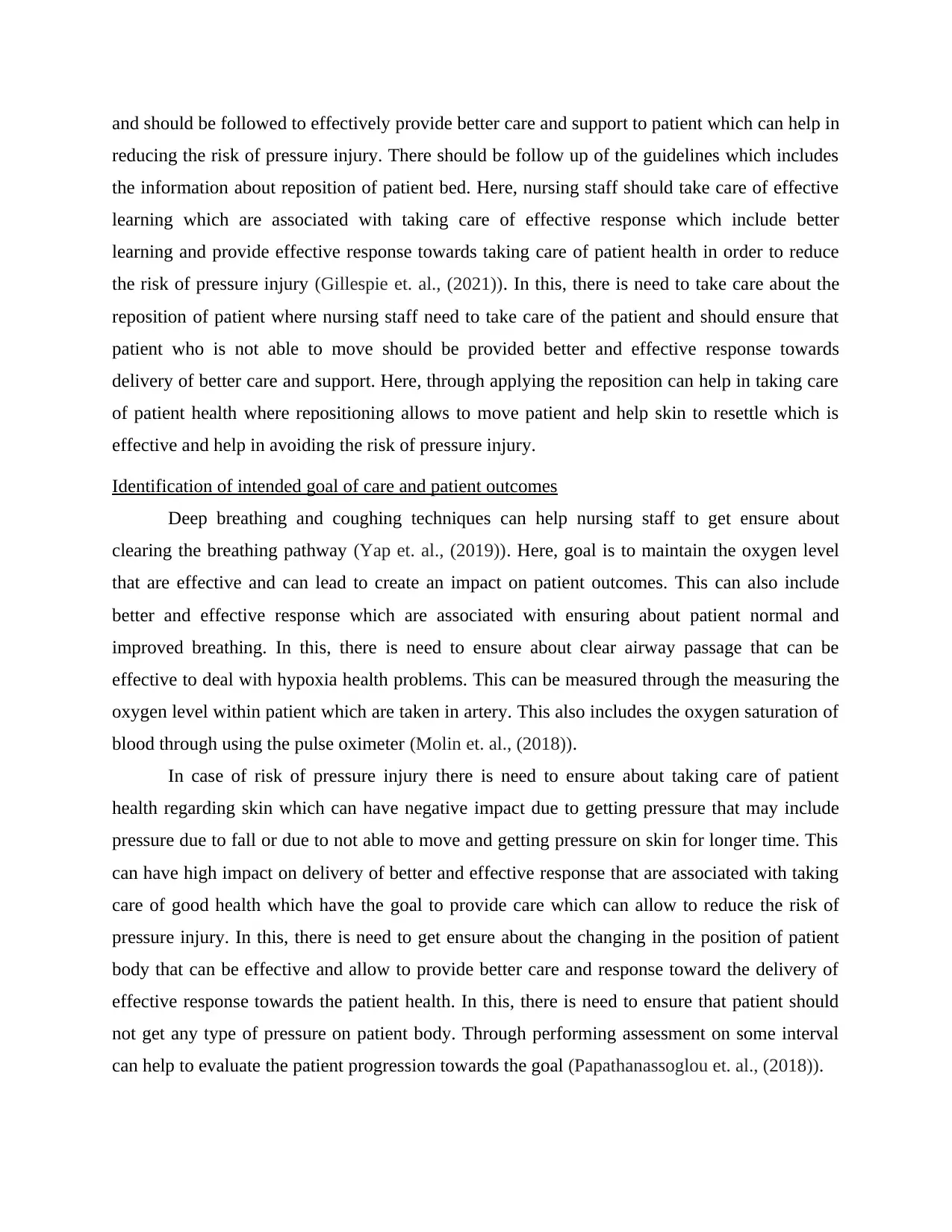
and should be followed to effectively provide better care and support to patient which can help in
reducing the risk of pressure injury. There should be follow up of the guidelines which includes
the information about reposition of patient bed. Here, nursing staff should take care of effective
learning which are associated with taking care of effective response which include better
learning and provide effective response towards taking care of patient health in order to reduce
the risk of pressure injury (Gillespie et. al., (2021)). In this, there is need to take care about the
reposition of patient where nursing staff need to take care of the patient and should ensure that
patient who is not able to move should be provided better and effective response towards
delivery of better care and support. Here, through applying the reposition can help in taking care
of patient health where repositioning allows to move patient and help skin to resettle which is
effective and help in avoiding the risk of pressure injury.
Identification of intended goal of care and patient outcomes
Deep breathing and coughing techniques can help nursing staff to get ensure about
clearing the breathing pathway (Yap et. al., (2019)). Here, goal is to maintain the oxygen level
that are effective and can lead to create an impact on patient outcomes. This can also include
better and effective response which are associated with ensuring about patient normal and
improved breathing. In this, there is need to ensure about clear airway passage that can be
effective to deal with hypoxia health problems. This can be measured through the measuring the
oxygen level within patient which are taken in artery. This also includes the oxygen saturation of
blood through using the pulse oximeter (Molin et. al., (2018)).
In case of risk of pressure injury there is need to ensure about taking care of patient
health regarding skin which can have negative impact due to getting pressure that may include
pressure due to fall or due to not able to move and getting pressure on skin for longer time. This
can have high impact on delivery of better and effective response that are associated with taking
care of good health which have the goal to provide care which can allow to reduce the risk of
pressure injury. In this, there is need to get ensure about the changing in the position of patient
body that can be effective and allow to provide better care and response toward the delivery of
effective response towards the patient health. In this, there is need to ensure that patient should
not get any type of pressure on patient body. Through performing assessment on some interval
can help to evaluate the patient progression towards the goal (Papathanassoglou et. al., (2018)).
reducing the risk of pressure injury. There should be follow up of the guidelines which includes
the information about reposition of patient bed. Here, nursing staff should take care of effective
learning which are associated with taking care of effective response which include better
learning and provide effective response towards taking care of patient health in order to reduce
the risk of pressure injury (Gillespie et. al., (2021)). In this, there is need to take care about the
reposition of patient where nursing staff need to take care of the patient and should ensure that
patient who is not able to move should be provided better and effective response towards
delivery of better care and support. Here, through applying the reposition can help in taking care
of patient health where repositioning allows to move patient and help skin to resettle which is
effective and help in avoiding the risk of pressure injury.
Identification of intended goal of care and patient outcomes
Deep breathing and coughing techniques can help nursing staff to get ensure about
clearing the breathing pathway (Yap et. al., (2019)). Here, goal is to maintain the oxygen level
that are effective and can lead to create an impact on patient outcomes. This can also include
better and effective response which are associated with ensuring about patient normal and
improved breathing. In this, there is need to ensure about clear airway passage that can be
effective to deal with hypoxia health problems. This can be measured through the measuring the
oxygen level within patient which are taken in artery. This also includes the oxygen saturation of
blood through using the pulse oximeter (Molin et. al., (2018)).
In case of risk of pressure injury there is need to ensure about taking care of patient
health regarding skin which can have negative impact due to getting pressure that may include
pressure due to fall or due to not able to move and getting pressure on skin for longer time. This
can have high impact on delivery of better and effective response that are associated with taking
care of good health which have the goal to provide care which can allow to reduce the risk of
pressure injury. In this, there is need to get ensure about the changing in the position of patient
body that can be effective and allow to provide better care and response toward the delivery of
effective response towards the patient health. In this, there is need to ensure that patient should
not get any type of pressure on patient body. Through performing assessment on some interval
can help to evaluate the patient progression towards the goal (Papathanassoglou et. al., (2018)).
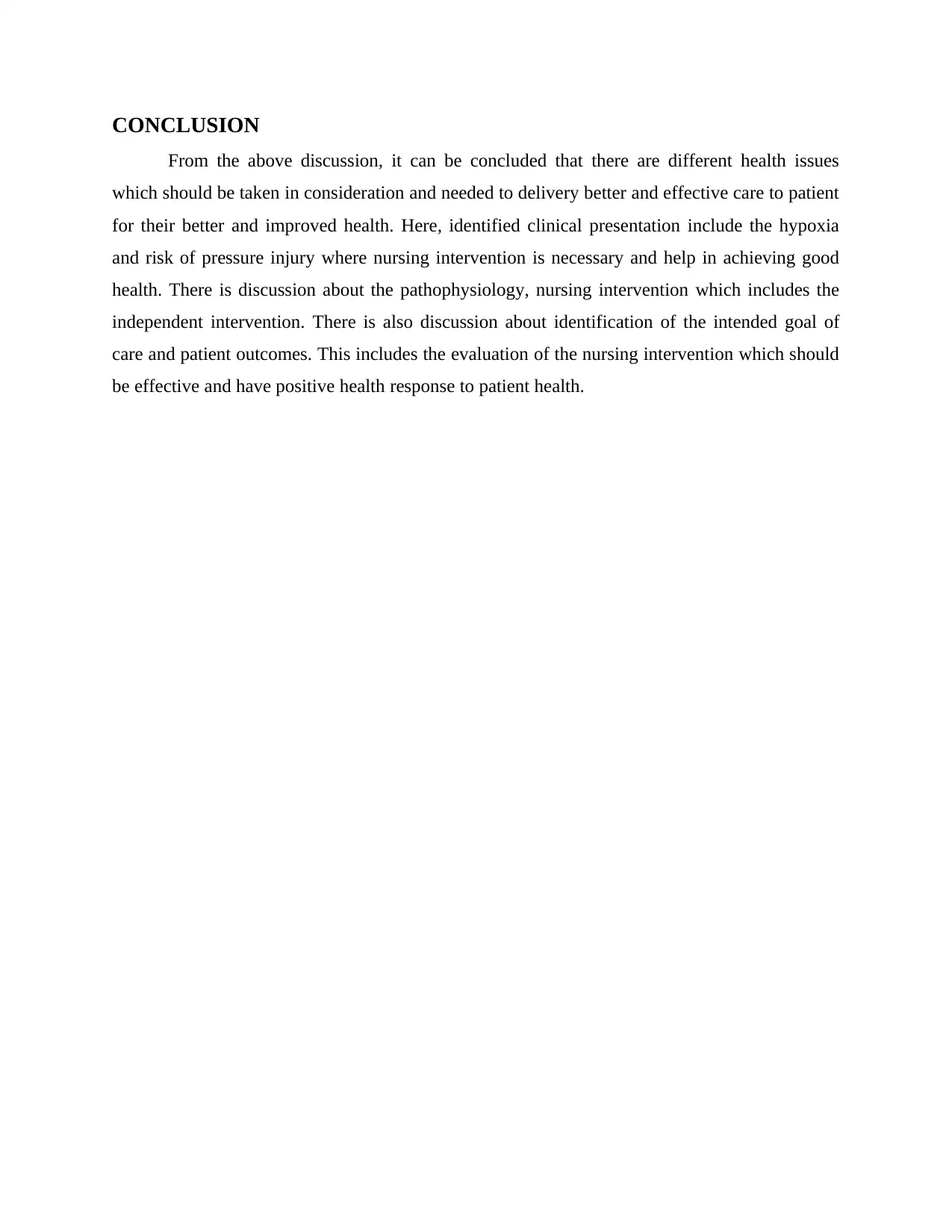
CONCLUSION
From the above discussion, it can be concluded that there are different health issues
which should be taken in consideration and needed to delivery better and effective care to patient
for their better and improved health. Here, identified clinical presentation include the hypoxia
and risk of pressure injury where nursing intervention is necessary and help in achieving good
health. There is discussion about the pathophysiology, nursing intervention which includes the
independent intervention. There is also discussion about identification of the intended goal of
care and patient outcomes. This includes the evaluation of the nursing intervention which should
be effective and have positive health response to patient health.
From the above discussion, it can be concluded that there are different health issues
which should be taken in consideration and needed to delivery better and effective care to patient
for their better and improved health. Here, identified clinical presentation include the hypoxia
and risk of pressure injury where nursing intervention is necessary and help in achieving good
health. There is discussion about the pathophysiology, nursing intervention which includes the
independent intervention. There is also discussion about identification of the intended goal of
care and patient outcomes. This includes the evaluation of the nursing intervention which should
be effective and have positive health response to patient health.
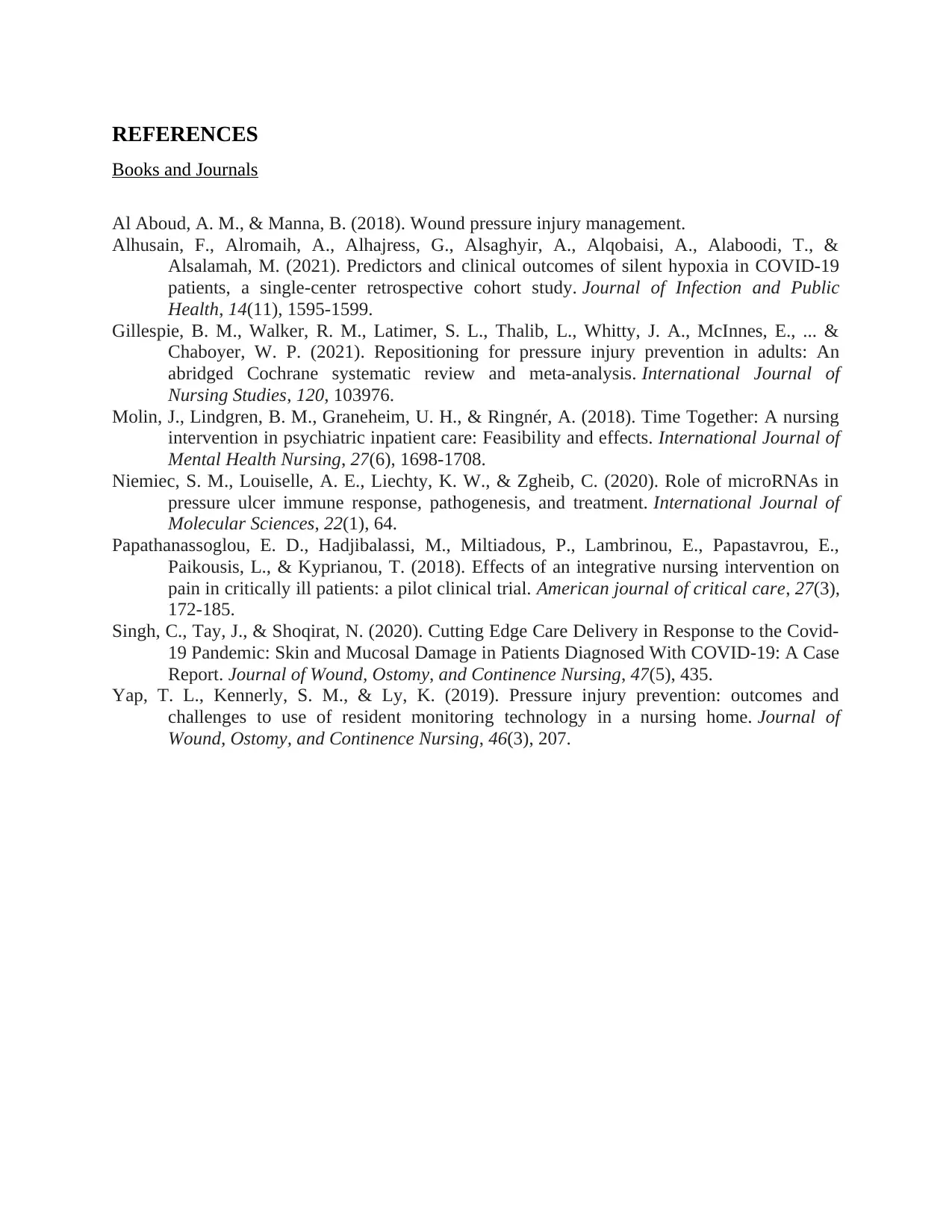
REFERENCES
Books and Journals
Al Aboud, A. M., & Manna, B. (2018). Wound pressure injury management.
Alhusain, F., Alromaih, A., Alhajress, G., Alsaghyir, A., Alqobaisi, A., Alaboodi, T., &
Alsalamah, M. (2021). Predictors and clinical outcomes of silent hypoxia in COVID-19
patients, a single-center retrospective cohort study. Journal of Infection and Public
Health, 14(11), 1595-1599.
Gillespie, B. M., Walker, R. M., Latimer, S. L., Thalib, L., Whitty, J. A., McInnes, E., ... &
Chaboyer, W. P. (2021). Repositioning for pressure injury prevention in adults: An
abridged Cochrane systematic review and meta-analysis. International Journal of
Nursing Studies, 120, 103976.
Molin, J., Lindgren, B. M., Graneheim, U. H., & Ringnér, A. (2018). Time Together: A nursing
intervention in psychiatric inpatient care: Feasibility and effects. International Journal of
Mental Health Nursing, 27(6), 1698-1708.
Niemiec, S. M., Louiselle, A. E., Liechty, K. W., & Zgheib, C. (2020). Role of microRNAs in
pressure ulcer immune response, pathogenesis, and treatment. International Journal of
Molecular Sciences, 22(1), 64.
Papathanassoglou, E. D., Hadjibalassi, M., Miltiadous, P., Lambrinou, E., Papastavrou, E.,
Paikousis, L., & Kyprianou, T. (2018). Effects of an integrative nursing intervention on
pain in critically ill patients: a pilot clinical trial. American journal of critical care, 27(3),
172-185.
Singh, C., Tay, J., & Shoqirat, N. (2020). Cutting Edge Care Delivery in Response to the Covid-
19 Pandemic: Skin and Mucosal Damage in Patients Diagnosed With COVID-19: A Case
Report. Journal of Wound, Ostomy, and Continence Nursing, 47(5), 435.
Yap, T. L., Kennerly, S. M., & Ly, K. (2019). Pressure injury prevention: outcomes and
challenges to use of resident monitoring technology in a nursing home. Journal of
Wound, Ostomy, and Continence Nursing, 46(3), 207.
Books and Journals
Al Aboud, A. M., & Manna, B. (2018). Wound pressure injury management.
Alhusain, F., Alromaih, A., Alhajress, G., Alsaghyir, A., Alqobaisi, A., Alaboodi, T., &
Alsalamah, M. (2021). Predictors and clinical outcomes of silent hypoxia in COVID-19
patients, a single-center retrospective cohort study. Journal of Infection and Public
Health, 14(11), 1595-1599.
Gillespie, B. M., Walker, R. M., Latimer, S. L., Thalib, L., Whitty, J. A., McInnes, E., ... &
Chaboyer, W. P. (2021). Repositioning for pressure injury prevention in adults: An
abridged Cochrane systematic review and meta-analysis. International Journal of
Nursing Studies, 120, 103976.
Molin, J., Lindgren, B. M., Graneheim, U. H., & Ringnér, A. (2018). Time Together: A nursing
intervention in psychiatric inpatient care: Feasibility and effects. International Journal of
Mental Health Nursing, 27(6), 1698-1708.
Niemiec, S. M., Louiselle, A. E., Liechty, K. W., & Zgheib, C. (2020). Role of microRNAs in
pressure ulcer immune response, pathogenesis, and treatment. International Journal of
Molecular Sciences, 22(1), 64.
Papathanassoglou, E. D., Hadjibalassi, M., Miltiadous, P., Lambrinou, E., Papastavrou, E.,
Paikousis, L., & Kyprianou, T. (2018). Effects of an integrative nursing intervention on
pain in critically ill patients: a pilot clinical trial. American journal of critical care, 27(3),
172-185.
Singh, C., Tay, J., & Shoqirat, N. (2020). Cutting Edge Care Delivery in Response to the Covid-
19 Pandemic: Skin and Mucosal Damage in Patients Diagnosed With COVID-19: A Case
Report. Journal of Wound, Ostomy, and Continence Nursing, 47(5), 435.
Yap, T. L., Kennerly, S. M., & Ly, K. (2019). Pressure injury prevention: outcomes and
challenges to use of resident monitoring technology in a nursing home. Journal of
Wound, Ostomy, and Continence Nursing, 46(3), 207.
1 out of 7
Related Documents
Your All-in-One AI-Powered Toolkit for Academic Success.
+13062052269
info@desklib.com
Available 24*7 on WhatsApp / Email
![[object Object]](/_next/static/media/star-bottom.7253800d.svg)
Unlock your academic potential
© 2024 | Zucol Services PVT LTD | All rights reserved.





